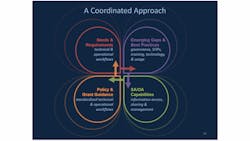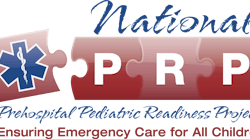Situational awareness (SA) is defined in Wikipedia as, “that which involves being aware of what is happening in the vicinity, in order to understand how information, events and one’s own actions will impact goals and objectives, both immediately and in the near future.” SA is more aligned when there is a catastrophic event or a serious emergency – during this heightened time of activity and critical decision making, SA will have an impact on the outcome. The effectiveness of SA depends on how successfully information is shared with and among the agencies, organizations and people involved.
The effectiveness of information sharing is based on properties identified in the Department of Homeland Security (DHS) SAFECOM Interoperability Continuum. As depicted, these properties are categorized by the following “lanes”:
1. Governance
2. Standard operating procedures (SOPs)
3. Technology (data and voice)
4. Training and exercises
5. Usage
Governance identifies oversight and defines roles and responsibilities necessary to information sharing. SOPs define the what, when and how information will be shared and with whom. Training and exercises are required to ensure that all involved know how to effectively share the information. Usage is most effective when the process of information is used on a daily basis and transforms situational awareness into a daily operational awareness (OA). OA then becomes the norm and establishes an organization’s or a locality’s baseline from which to better understand the impact that a significant event or emergency incident is having on the organization or locality.
I have saved technology (data and voice) for last due to the criticality of data. How data is published, organized and managed will ultimately determine how effectively information can be shared. Once the other lanes of the continuum have been addressed, use of data can be most productive when it is exists in a standardized data format and is managed within a common and shared data folder architecture and common symbology (for geospatial visualization). When the data lane is “right,” it simplifies how information can be shared and dramatically enhances technologies that can publish, access, consume and share information.
The National Information Sharing Consortium (NISC) was organized to identify what is necessary to develop an effective information-sharing environment. Every day, national security data is growing in volume and complexity. Unparalleled stakeholder participation and collaboration are needed so government at all levels can mitigate threats (both natural and man-made) and effectively respond to incidents when needed. A rigorous approach to establish critical information-sharing requirements and define standards-based approaches to secure incident management information sharing is needed to address this complex exchange. The NISC is dedicated to address this critical endeavor and bases its initiatives and activities upon a coordinated approach that validates needs and requirements, culls emerging gaps and best practices, maximizes SA/OA capabilities and influences policy and grant guidance.
The organization’s leaders have been working with leadership of the DHS Science and Technology Directorate and White House Program Manager for the Information Sharing Environment by co-chairing an advisory body – the Incident Management Information Sharing Subcommittee (IMIS-SC) – to develop a national strategy on information sharing. This strategy would help to standardize how information is shared between public safety disciplines, public service and all levels of government, non-governmental organizations and the private sector. A reliable flow of information between all of these entities is required to respond to and mitigate both daily emergency incidents and catastrophic natural and manmade disasters.
The IMIS-SC’s focus is described in its charter:
“To address the information-sharing needs of federal, tribal, state and local emergency management sector, the White House Information Sharing and Access Interagency Policy Committee (ISA IPC) has chartered the Incident Management Information Sharing Subcommittee (IMIS-SC). The IMIS-SC will provide guidance and policy recommendations to the ISA-IPC – from local, state, federal and industry perspectives – on ways to both expand and institutionalize nationwide incident management information sharing capabilities and system interoperability across the homeland security enterprise. Importantly, the recommendations and technology initiatives established by the IMIS-SC directly complement the goals and objectives of the Standards Coordinating Council (SCC) and other subcommittees reporting to the ISA-IPC.”
The NISC is also taking a focused look at information-sharing needs at the local level, specifically first responders. The NISC has received a DHS grant for its “Local First Responder Information Sharing Decision Support Project,” a series of technical assistance engagements that will involve exploring day-to-day operational needs within and across public safety disciplines. Emphasis will be placed on methods for managing information to enable informed decision making at every point in the chain of response, including points that require state-level involvement.
Using the NISC’s coordinated approach, lessons learned and best practices from all its engagements and activities will inform the establishment of an information sharing environment that maximizes access to nationally-relevant data in a multitude of ways, using a variety of tools that support publication, management and sharing of data products such as aggregated web maps, apps and direct access to data libraries. These efforts are conducted in partnership with DHS S&T as S&T’s transition partner for the Virtual USA Program – a program that is focused on building capacity of state and local agencies’ incident-management communications and information-sharing capabilities. S&T’s ongoing national leadership role in advancing information sharing among all levels of government and the private sector underscores the critical importance of this partnership for helping the NISC reach its goals.
The NISC now has more than 75 local, state and international organizations as members and it continues to expand. To find more information about the NISC and how you can join (membership is FREE for the public sector) and get involved, visit http://www.nisconsortium.org.






